| Argiope protensa | |
|---|---|
 | |
| Scientific classification | |
| Domain: | Eukaryota |
| Kingdom: | Animalia |
| Phylum: | Arthropoda |
| Subphylum: | Chelicerata |
| Class: | Arachnida |
| Order: | Araneae |
| Infraorder: | Araneomorphae |
| Family: | Araneidae |
| Genus: | Argiope |
| Species: | A. protensa |
| Binomial name | |
| Argiope protensa | |
Argiope protensa, commonly known as the tailed grass spider[2] or teardrop spider,[3] is a species of spider in the orb weaver family, Araneidae. This species is fairly common and widespread in Australasia,[4] but like many spider species, little is known of its ecology, biology, or life history.[5]
Description
Argiope protensa is a slender, medium-sized spider, reaching a body length of 13 – 25 mm.[3][6][7] Its abdomen is distinctively elongate, tapering to a long “tail” extending beyond the ventrally-positioned spinnerets — though immature and/or male specimens may not clearly show this characteristic.[7] The dorsal abdomen has on each side a finely pubescent strip of short, silvery hairs, which become sparse closer to the apex. Four to six pairs of weakly indented spots border the variably-coloured, hairless medial line; similar hairless dark strips run along the sides of the abdomen. Ventrally, the abdomen is dark and sparsely-haired; two pale stripes run longitudinally down its entire length to the apex. The cephalothorax makes up about a quarter of the body length, and is covered in silvery-grey hairs on its dorsal surface. Colouration of the legs can vary between individuals; some are almost uniformly grey-brown, while others have strongly contrasting bands of dark and light colour along their lengths. In descending order, the relative leg lengths are 1, 2, 4, 3.[6] In Australia, Argiope protensa can be distinguished from A. probata (the only other Argiope species with a similarly-shaped abdomen) by examining morphological characteristics of the epigyne.[7]
The tailed grass spider's web is variable, usually quite small (especially compared to those of other Argiope species), and may be constructed close to the ground[8] and oriented on a plane anywhere between vertical and horizontal.[3] A 2022 analysis of 262 photographs showing 124 different tailed grass spider webs across Australia and New Zealand showed 38.7% contained a structure known as a stabilimentum,[8] the purpose of which is yet to be determined.[9]
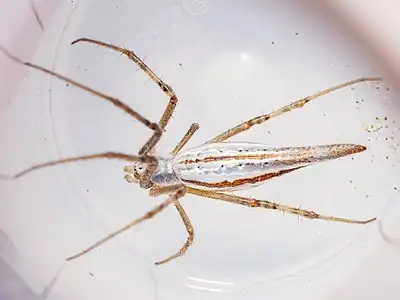 Adult female Argiope protensa dorsal view
Adult female Argiope protensa dorsal view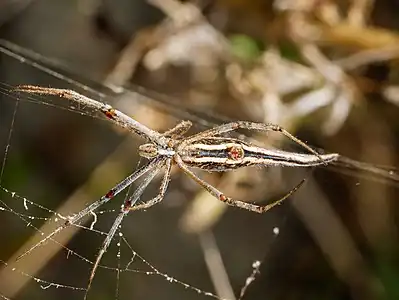 Adult female ventral view
Adult female ventral view
Distribution
Argiope protensa is recorded from Australia, New Zealand, New Caledonia and New Guinea.[4] It is considered native to New Zealand, believed to have arrived from Australia by natural means;[10] scrutiny of early collection records and/or comparative genetic analysis would be required to confirm this and estimate a time of first arrival.[11] A 2014 study analysed changes in spider assemblage composition of Australian grasslands across a 900 km environmental gradient, and found a strong positive relationship between A. protensa and taller vegetation with high intra-tussock density.[12]
Life cycle
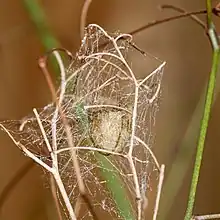
The length of the tailed grass spider’s life cycle is unknown but, like similar species, probably lasts no more than two years.[13] Females reach maturity in midsummer, and produce cup-shaped egg masses in the late summer.[3] It is unknown when the young hatch from their eggs. Ballooning is probably an important mechanism by which the young disperse to new habitats,[14] and is likely how this species reached New Zealand from Australia. [15]
Interactions
As an orb-weaving spider, Argiope protensa is a generalist predator and will consume any invertebrates it can capture and subdue, though some preferential selection of prey may occur, as seen in other araneid spiders.[16][17][18] Prey is usually restrained by wrapping with broad swathes of dense silk, which is a common behaviour in other species in this genus.[9]
Further information
Argiope protensa was first described from Australia by L. Koch in 1872;[19] in 1885 it was also described as Epeira attenuata by Urquhart from specimens collected in New Zealand.[6] Several other synonyms exist from different collection locations.[4] Taxonomic confusion continued until 1971, when Chrysanthus[20] confirmed that specimens collected from New Guinea matched Koch’s original description; in 1983 Levi agreed that similarities in genital morphology suggested many of the previously-described Australasian species were synonyms.[7] In 2017, phylogenetic analysis by Wheeler et al. confirmed the placement of Argiope within the family Araneidae.[21]
Gallery
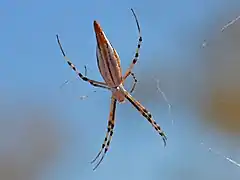 Argiope protensa dorsal view
Argiope protensa dorsal view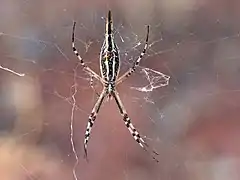 Ventral view — note strong bands of colour on legs
Ventral view — note strong bands of colour on legs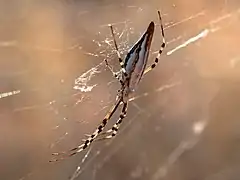 Side view
Side view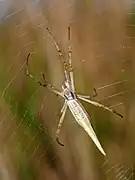 Subadult female — note yellow medial line
Subadult female — note yellow medial line
References
- ↑ "Taxon details Argiope protensa L. Koch, 1872", World Spider Catalog, Natural History Museum Bern, retrieved 2019-06-28
- ↑ Handbook of New Zealand insect names : common and scientific names for insects and allied organisms. Auckland [N.Z.]: Entomological Society of New Zealand. 1999. ISBN 978-0-95-976635-6.
- 1 2 3 4 Main, Barbara York (1980). Spiders of Australia : a guide to their identification with brief notes on the natural history of common forms. [Kent Town, S. Aust.]: Axiom Books. ISBN 9780959416435.
- 1 2 3 "Argiope protensa L. Koch, 1872 COL". www.catalogueoflife.org. Retrieved 13 April 2022.
- ↑ Vink, Cor J. (3 July 2017). "A history of araneology in New Zealand". Journal of the Royal Society of New Zealand. 47 (3): 262–273. doi:10.1080/03036758.2017.1334676. ISSN 0303-6758. S2CID 134908799.
- 1 2 3 Urquhart, A. T. (1885). "On the spiders of New Zealand". Transactions of the New Zealand Institute. 17: 31–53.
- 1 2 3 4 Levi, H. W. (1983). "The orb-weaver genera Argiope, Gea, and Neogea from the western Pacific region (Araneae: Araneidae, Argiopinae)". Bulletin of the Museum of Comparative Zoology. 150: 247–338.
- 1 2 Kerr, Alexander M. (December 2021). "Pattern and frequency of web decorating by Argiope protensa L. Koch, 1872 (Araneae: Araneidae)". The Journal of Arachnology. 49 (3): 389–392. doi:10.1636/JoA-S-20-059. ISSN 0161-8202. S2CID 245016784.
- 1 2 Walter, André (1 June 2018). "Tracing the evolutionary origin of a visual signal: the coincidence of wrap attack and web decorating behaviours in orb web spiders (Araneidae)". Evolutionary Ecology. 32 (2): 159–170. doi:10.1007/s10682-018-9930-y. ISSN 1573-8477. S2CID 254464459.
- ↑ Framenau, Volker W.; de S. Castanheira, Pedro; Vink, Cor J. (13 January 2022). "Taxonomy and systematics of the new Australo-Pacific orb-weaving spider genus Socca (Araneae: Araneidae)". New Zealand Journal of Zoology. 49 (4): 263–334. doi:10.1080/03014223.2021.2014899. ISSN 0301-4223. S2CID 245966787.
- ↑ Griffiths, James W.; Paterson, Adrian M.; Vink, Cor J. (December 2005). "MOLECULAR INSIGHTS INTO THE BIOGEOGRAPHY AND SPECIES STATUS OF NEW ZEALAND'S ENDEMIC LATRODECTUS SPIDER SPECIES; L. KATIPO AND L. ATRITUS (ARANEAE, THERIDIIDAE)". The Journal of Arachnology. 33 (3): 776–784. doi:10.1636/S04-11.1. hdl:10182/502. ISSN 0161-8202. S2CID 11655617.
- ↑ Gibb, H.; Muscat, D.; Binns, M. R.; Silvey, C. J.; Peters, R. A.; Warton, D. I.; Andrew, N. R. (2015). "Responses of foliage-living spider assemblage composition and traits to a climatic gradient in T hemeda grasslands: Spider Traits and Climatic Gradients". Austral Ecology. 40 (3): 225–237. doi:10.1111/aec.12195.
- ↑ Moore, Clovis W. (July 1977). "The Life Cycle, Habitat and Variation in Selected Web Parameters in the Spider, Nephila clavipes Koch (Araneidae)". The American Midland Naturalist. 98 (1): 95–108. doi:10.2307/2424717. JSTOR 2424717.
- ↑ Blandenier, Gilles (March 2009). "Ballooning of spiders (Araneae) in Switzerland: General Results from an Eleven-Year Survey". Arachnology. 14 (7): 308–316. doi:10.13156/arac.2009.14.7.308. S2CID 84318695.
- ↑ "Spiders — destination New Zealand". collections.tepapa.govt.nz.
- ↑ Ludy, C. (March 2007). "Prey selection of orb-web spiders (Araneidae) on field margins". Agriculture, Ecosystems & Environment. 119 (3–4): 368–372. doi:10.1016/j.agee.2006.08.005.
- ↑ Meraz, L.C.; Hénaut, Y.; Legal, L. (January 2012). "Prey selection in a nocturnal web-building spider, Eriophora edax (Araneae Araneidae)". Ethology Ecology & Evolution. 24 (1): 1–13. doi:10.1080/03949370.2011.582887. S2CID 83627574.
- ↑ Uetz, George W.; Hartsock, Scott P. (1987). "Prey Selection in an Orb-Weaving Spider: Micrathena Gracilis (Araneae: Araneidae)". Psyche. 94 (1–2): 103–116. doi:10.1155/1987/16298. ISSN 0033-2615.
- ↑ Koch, Ludwig; Keyserling, Eduard von; Keyserling, Eugen; Koch, Carl (1871). "Die Arachniden Australiens nach der Natur beschrieben und abgebildet". Verlag von Bauer & Raspe. doi:10.5962/bhl.title.121660.
{{cite journal}}: Cite journal requires|journal=(help) - ↑ Chrysanthus, P. (1971). "Further notes on the spiders of New Guinea I." Zoologische Verhandelingen. 113: 1–52.
- ↑ Wheeler, Ward C.; Coddington, Jonathan A.; Crowley, Louise M.; Dimitrov, Dimitar; Goloboff, Pablo A.; Griswold, Charles E.; Hormiga, Gustavo; Prendini, Lorenzo; Ramírez, Martín J.; Sierwald, Petra; Almeida‐Silva, Lina; Alvarez‐Padilla, Fernando; Arnedo, Miquel A.; Benavides Silva, Ligia R.; Benjamin, Suresh P.; Bond, Jason E.; Grismado, Cristian J.; Hasan, Emile; Hedin, Marshal; Izquierdo, Matías A.; Labarque, Facundo M.; Ledford, Joel; Lopardo, Lara; Maddison, Wayne P.; Miller, Jeremy A.; Piacentini, Luis N.; Platnick, Norman I.; Polotow, Daniele; Silva‐Dávila, Diana; Scharff, Nikolaj; Szűts, Tamás; Ubick, Darrell; Vink, Cor J.; Wood, Hannah M.; Zhang, Junxia (December 2017). "The spider tree of life: phylogeny of Araneae based on target‐gene analyses from an extensive taxon sampling". Cladistics. 33 (6): 574–616. doi:10.1111/cla.12182. PMID 34724759. S2CID 35535038.
External links
 Media related to Argiope protensa at Wikimedia Commons
Media related to Argiope protensa at Wikimedia Commons- Argiope protensa